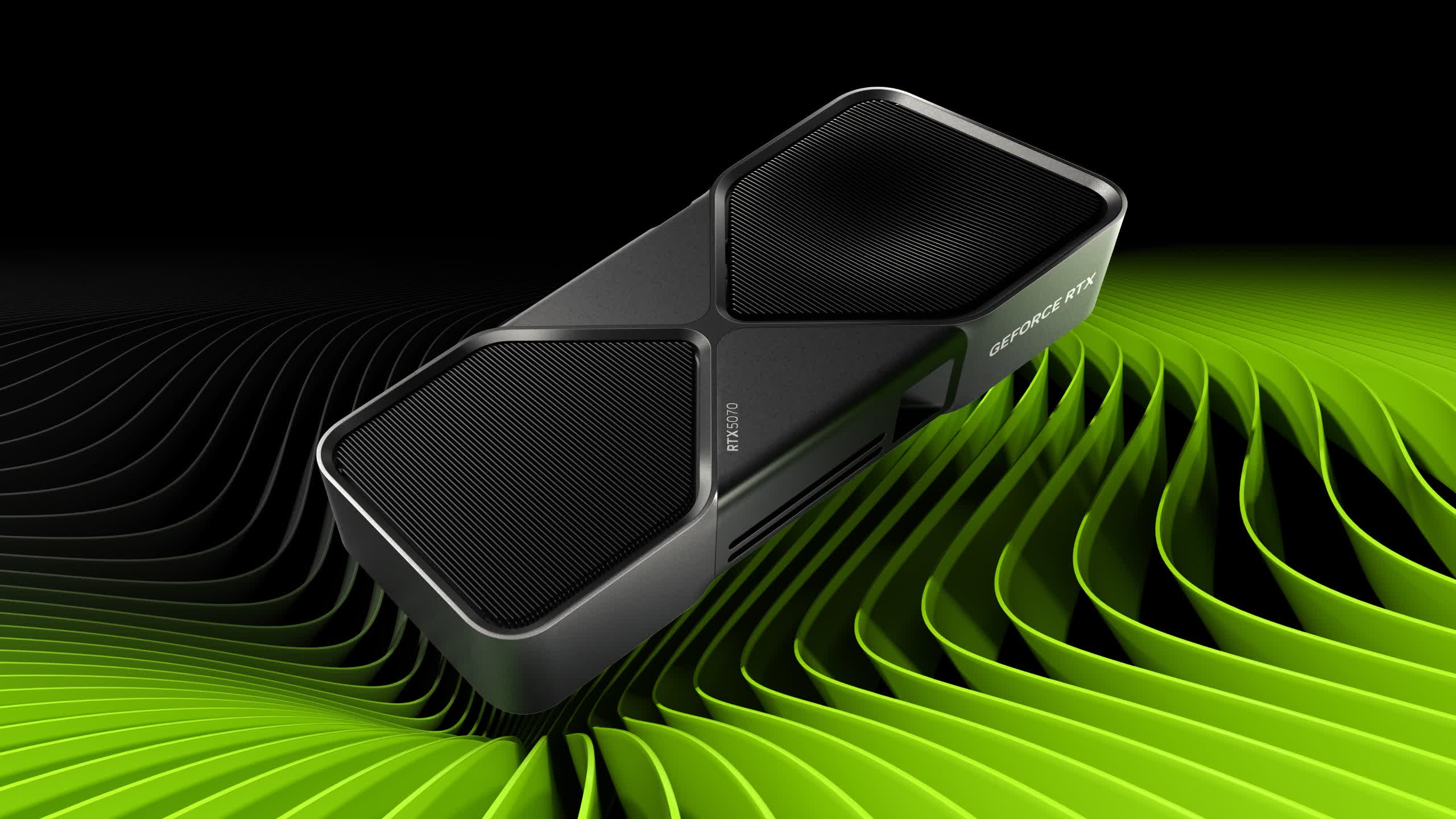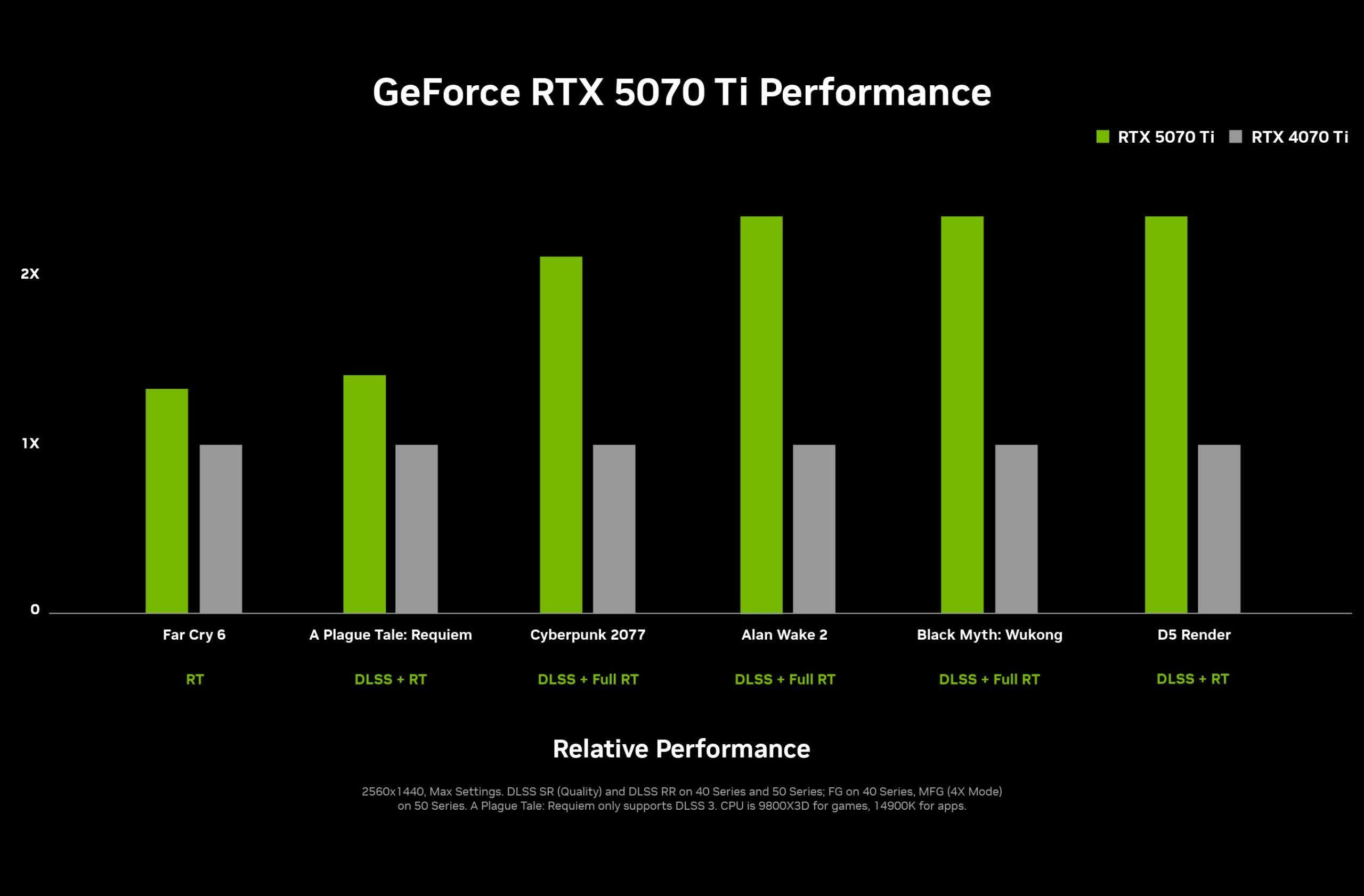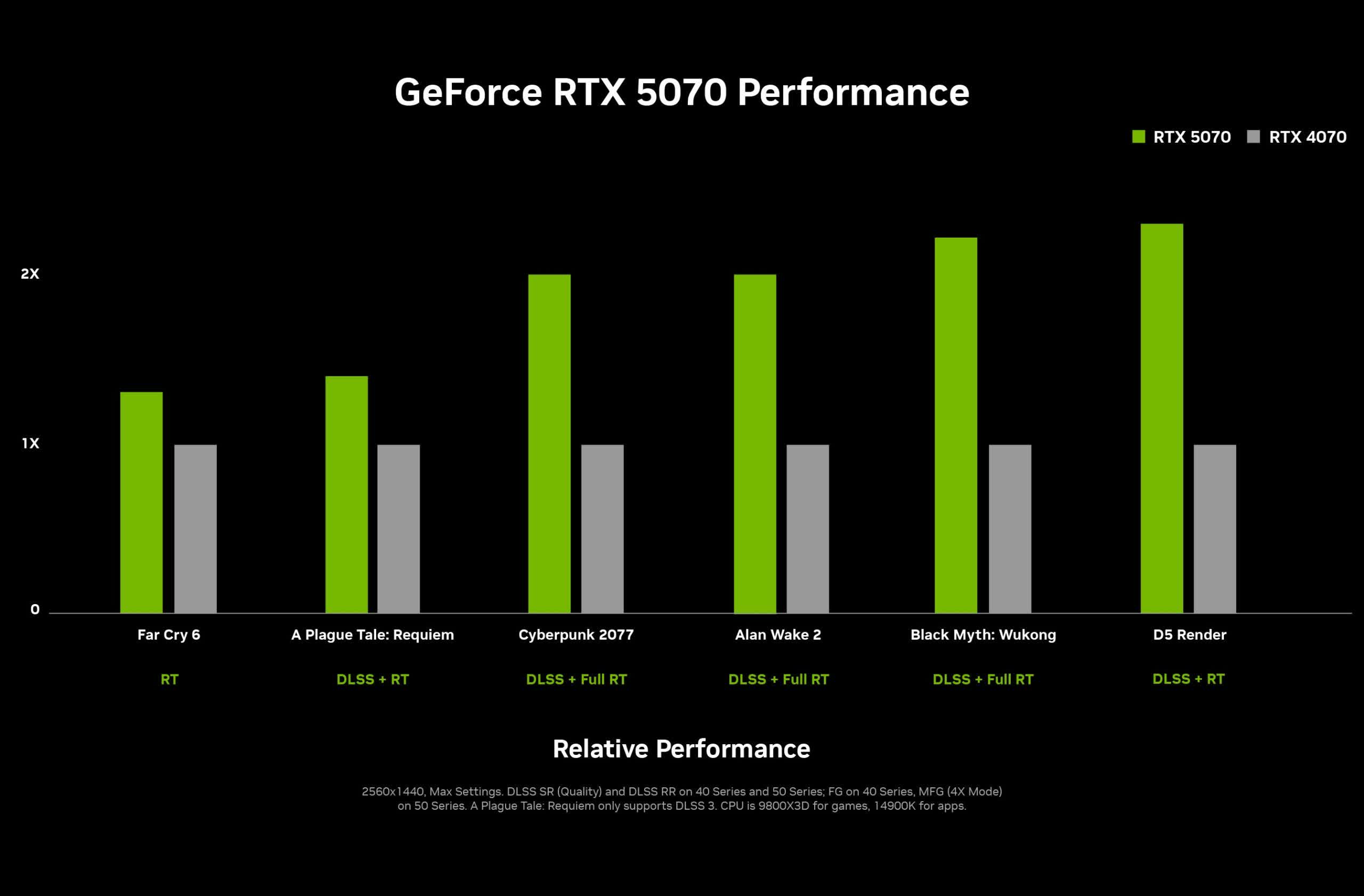What just happened? After all the anticipation over the arrival of Nvidia's RTX 5000 graphics cards, gamers have been disappointed by the lukewarm reviews of the RTX 5090 and 5080. But what about cards further down the product stack? Team Green has just released the full RTX 5070 and 5070 Ti specs, and it looks like Blackwell still isn't going to see much love from consumers.
Nvidia revealed the RTX 5070 / 5070 Ti at CES alongside the 5090 and 5080. The main specs were already known, but now the company has released an official document that dives further into the hardware.
Starting with the more powerful 5070 Ti, the card is based on the same GB203 GPU as the RTX 5080. It also has the same 16GB of GDDR7 VRAM with a memory bus width of 256-bit, but the memory speed is reduced from 30 Gbps to 28 Gbps.
The RTX 5070 Ti also has a TGP of 300W, 15W more than the RTX 4070 Ti. It will arrive with an MSRP of $549.
| Graphics Card | RTX 3070 Ti | RTX 4070 Ti | RTX 5070 Ti |
|---|---|---|---|
| GPU Codename | GA104 | AD104 | GB203 |
| GPU Architecture | NVIDIA Ampere | NVIDIA Ada Lovelace | NVIDIA Blackwell |
| GPCs | 6 | 5 | 6 |
| TPCs | 24 | 30 | 35 |
| SMs | 48 | 60 | 70 |
| CUDA Cores / SM | 128 | 128 | 128 |
| CUDA Cores / GPU | 6144 | 7680 | 8960 |
| Tensor Cores / SM | 4 (3rd Gen) | 4 (4th Gen) | 4 (5th Gen) |
| Tensor Cores / GPU | 192 (3rd Gen) | 240 (4th Gen) | 280 (5th Gen) |
| RT Cores | 48 (2nd Gen) | 60 (3rd Gen) | 70 (4th Gen) |
| GPU Boost Clock (MHz) | 1770 | 2610 | 2452 |
| Peak FP32 TFLOPS | 21.7 | 40.1 | 43.9 |
| RT TFLOPS | 42.5 | 92.7 | 133.2 |
| Frame Buffer Memory Size and Type | 8 GB GDDR6X | 12 GB GDDR6X | 16 GB GDDR7 |
| Memory Interface | 256-bit | 192-bit | 256-bit |
| Memory Clock (Data Rate) | 19 Gbps | 21 Gbps | 28 Gbps |
| Memory Bandwidth | 608 GB/sec | 504 GB/sec | 896 GB/sec |
| ROPs | 96 | 80 | 96 |
| Pixel Fill-rate (Gigapixels/sec) | 169.9 | 208.8 | 235.4 |
| Texture Units | 192 | 240 | 280 |
| Texel Fill-rate (Gigatexels/sec) | 339.84 | 626.4 | 686.6 |
| L1 Data Cache/Shared Memory | 6144 KB | 7680 KB | 8960 KB |
| L2 Cache Size | 4096 KB | 49152 KB | 49152 KB |
| Register File Size | 12288 KB | 15360 KB | 17920 KB |
| Video Engines | 1 x NVENC (7th Gen), 1 x NVDEC (5th Gen) | 2 x NVENC (8th Gen), 1 x NVDEC (5th Gen) | 2 x NVENC (9th Gen), 1 x NVDEC (6th Gen) |
| TGP (Total Graphics Power) | 290 W | 285 W | 300 W |
| Transistor Count | 17.4 Billion | 35.8 Billion | 45.6 Billion |
| Die Size | 392.5 mm² | 294.5 mm² | 378 mm² |
| Manufacturing Process | Samsung 8 nm 8N | TSMC 4nm 4N | TSMC 4nm 4N |
| PCI Express Interface | Gen 4 | Gen 4 | Gen 5 |
Nvidia has provided its typically vague performance comparison charts for the card, putting it up against the RTX 4070 Ti. Unsurprisingly, five of the six benchmarks are with DLSS enabled.
Moving onto the RTX 5070, it features the GB205 GPU, whereas previous-generation equivalents have used xx104 dies. It has 12GB of VRAM (192-bit), the same as the RTX 4070, though it is of the GDDR7 variety and clocked at a faster 28 Gbps. Memory bandwidth is up from 507 GB/s to 672 GB/s.
The 5070's TGP is 250W, 50W more than its predecessor and 30W more than the RTX 4070 Super. The MSRP has yet to be revealed. As a reminder, the $799 RTX 4070 Ti was $200 more than the $599 RTX 4070 at launch.
| Graphics Card | RTX 3070 | RTX 4070 | RTX 5070 |
|---|---|---|---|
| GPU Codename | GA104 | AD104 | GB205 |
| GPU Architecture | NVIDIA Ampere | NVIDIA Ada Lovelace | NVIDIA Blackwell |
| GPCs | 6 | 5 | 5 |
| TPCs | 23 | 23 | 24 |
| SMs | 46 | 46 | 48 |
| CUDA Cores / SM | 128 | 128 | 128 |
| CUDA Cores / GPU | 5888 | 5888 | 6144 |
| Tensor Cores / SM | 4 (3rd Gen) | 4 (4th Gen) | 4 (5th Gen) |
| Tensor Cores / GPU | 184 (3rd Gen) | 184 (4th Gen) | 192 (5th Gen) |
| RT Cores | 46 (2nd Gen) | 46 (3rd Gen) | 48 (4th Gen) |
| GPU Boost Clock (MHz) | 1725 | 2475 | 2512 |
| Peak FP32 TFLOPS | 20.3 | 29.1 | 30.9 |
| RT TFLOPS | 39.7 | 67.4 | 93.6 |
| Frame Buffer Memory Size and Type | 8 GB GDDR6 | 12 GB GDDR6X | 12 GB GDDR7 |
| Memory Interface | 256-bit | 192-bit | 192-bit |
| Memory Clock (Data Rate) | 14 Gbps | 21 Gbps | 28 Gbps |
| Memory Bandwidth | 448 GB/sec | 504 GB/sec | 672 GB/sec |
| ROPs | 96 | 64 | 80 |
| Pixel Fill-rate (Gigapixels/sec) | 165.6 | 158.4 | 201 |
| Texture Units | 184 | 184 | 192 |
| Texel Fill-rate (Gigatexels/sec) | 317.4 | 455.4 | 482.3 |
| L1 Data Cache/Shared Memory | 5888 KB | 5888 KB | 6144 KB |
| L2 Cache Size | 4096 KB | 36864 KB | 49152 KB |
| Register File Size | 11776 KB | 11776 KB | 12288 KB |
| Video Engines | 1 x NVENC (7th Gen), 1 x NVDEC (5th Gen) | 1 x NVENC (8th Gen), 1 x NVDEC (5th Gen) | 1 x NVENC (9th Gen), 1 x NVDEC (6th Gen) |
| TGP (Total Graphics Power) | 220 W | 200 W | 250 W |
| Transistor Count | 17.4 Billion | 31.1 Billion | 35.8 Billion |
| Die Size | 392.5 mm² | 294.5 mm² | 263 mm² |
| Manufacturing Process | Samsung 8 nm 8N | TSMC 4nm 4N | TSMC 4nm 4N |
| PCI Express Interface | Gen 4 | Gen 4 | Gen 5 |
Here is Nvidia's performance chart for the RTX 5070, putting it up against the RTX 4070.
While Nvidia hasn't revealed launch dates, the RTX 5070 Ti is rumored to release on February 20. There are no reports yet on when the RTX 5070 will arrive.
It's always worth waiting for reviews of cards before making a judgment, of course, but most reactions to the specs have not been positive, especially in light of the RTX 5090 and RTX 5080 reviews, which we scored 80 and 70, respectively.
A key question now is whether AMD, which is prioritizing more affordable mid-range cards in its Radeon RX 9000 series, can capitalize on consumer apathy toward Blackwell. The RX 9070 XT, RX 9070, RX 9060, and RX 9050 will start to go on sale this March.
Nvidia unveils the full GeForce RTX 5070 and RTX 5070 Ti specifications


